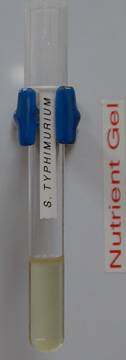Gelatinase Test
Nutrient gelatin is a differential medium that tests the ability of an organism to produce an exoenzyme, called gelatinase, that hydrolyzes gelatin.
Gelatin is commonly known as a component of gelled salads and some desserts, but it's actually a protein derived from connective tissue. When gelatin is at a temperature below 32°C (or within a few degrees thereof), it is a semisolid material. At temperatures above 32°C, it is a viscous liquid.
Gelatinase allows the organisms that produce it to break down gelatin into smaller polypeptides, peptides, and amino acids that can cross the cell membrane and be utilized by the organism.
When gelatin is broken down, it can no longer solidify. If
an organism can break down gelatin, the areas where the organism has
grown will remain liquid even if the gelatin is refrigerated.
 |
 |
The Serratia marcescens on the left is positive for
gelatinase production, as evidenced by the liquidation of the media. |
The Salmonella typhimurium on the right is negative,
as evidenced by the solidity of the media. |
The gelatinase test can be used to differentiate between Staphylococcus aureus and Staphylococcus epidermidis . It can also be used to differentiate Serratia marcescens, Proteus vulgaris, and Proteus mirabilis from other enterics.
